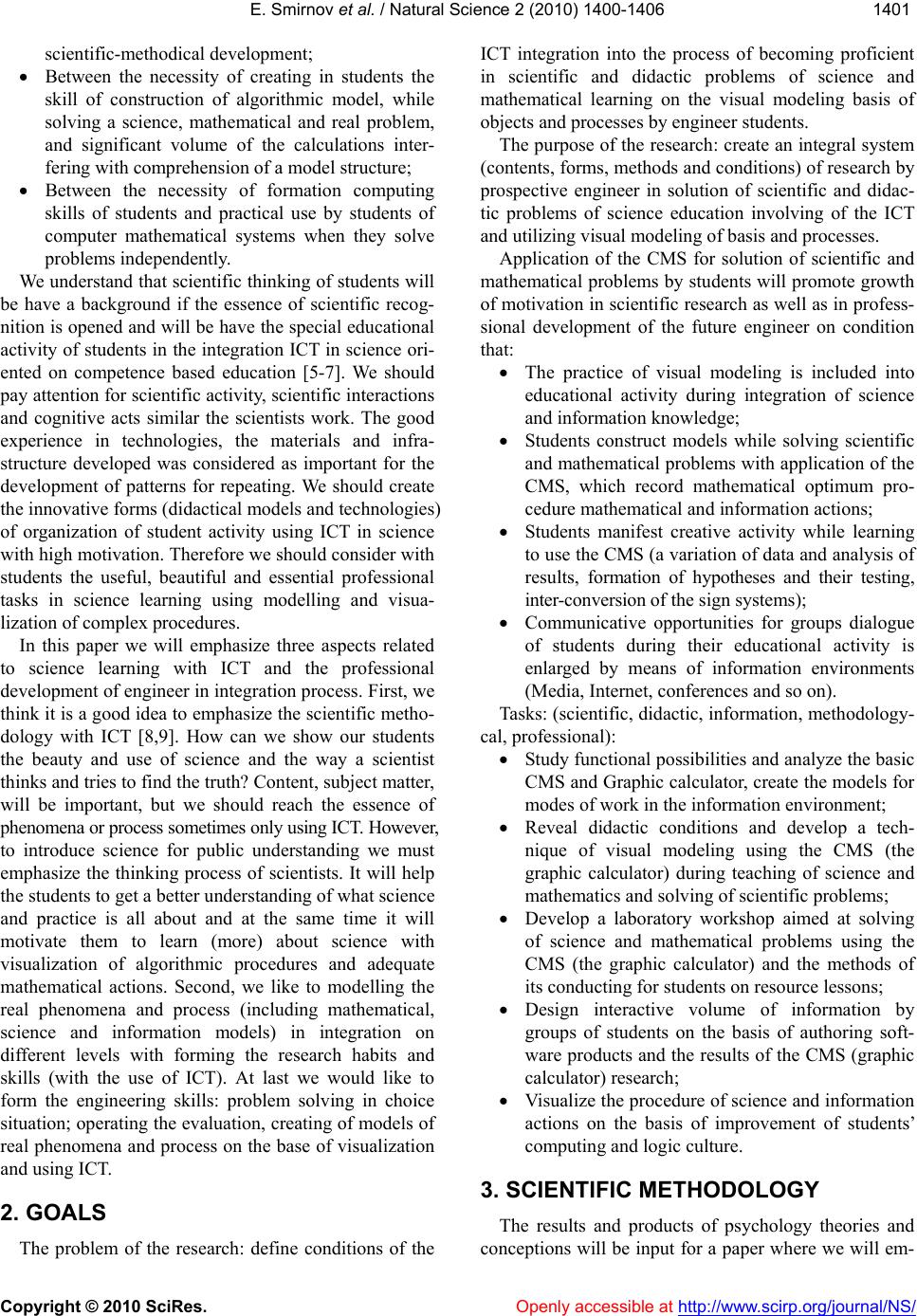
E. Smirnov et al. / Natural Science 2 (2010) 1400-1406
Copyright © 2010 SciRes. Openly accessible at http://www.scirp.org/journal/NS/
140
1401
scientific-methodical development;
Between the necessity of creating in students the
skill of construction of algorithmic model, while
solving a science, mathematical and real problem,
and significant volume of the calculations inter-
fering with comprehension of a model structure;
Between the necessity of formation computing
skills of students and practical use by students of
computer mathematical systems when they solve
problems independently.
We understand that scientific thinking of students will
be have a background if the essence of scientific recog-
nition is opened and will be have the special educational
activity of students in the integration ICT in science ori-
ented on competence based education [5-7]. We should
pay attention for scientific activity, scientific interactions
and cognitive acts similar the scientists work. The good
experience in technologies, the materials and infra-
structure developed was considered as important for the
development of patterns for repeating. We should create
the innovative forms (didactical models and technologies)
of organization of student activity using ICT in science
with high motivation. Therefore we should consider with
students the useful, beautiful and essential professional
tasks in science learning using modelling and visua-
lization of complex procedures.
In this paper we will emphasize three aspects related
to science learning with ICT and the professional
development of engineer in integration process. First, we
think it is a good idea to emphasize the scientific metho-
dology with ICT [8,9]. How can we show our students
the beauty and use of science and the way a scientist
thinks and tries to find the truth? Content, subject matter,
will be important, but we should reach the essence of
phenomena or process sometimes only using ICT. However,
to introduce science for public understanding we must
emphasize the thinking process of scientists. It will help
the students to get a better understanding of what science
and practice is all about and at the same time it will
motivate them to learn (more) about science with
visualization of algorithmic procedures and adequate
mathematical actions. Second, we like to modelling the
real phenomena and process (including mathematical,
science and information models) in integration on
different levels with forming the research habits and
skills (with the use of ICT). At last we would like to
form the engineering skills: problem solving in choice
situation; operating the evaluation, creating of models of
real phenomena and process on the base of visualization
and using ICT.
2. GOALS
The problem of the research: define conditions of the
ICT integration into the process of becoming proficient
in scientific and didactic problems of science and
mathematical learning on the visual modeling basis of
objects and processes by engineer students.
The purpose of the research: create an integral system
(contents, forms, methods and conditions) of research by
prospective engineer in solution of scientific and didac-
tic problems of science education involving of the ICT
and utilizing visual modeling of basis and processes.
Application of the CМS for solution of scientific and
mathematical problems by students will promote growth
of motivation in scientific research as well as in profess-
sional development of the future engineer on condition
that:
The practice of visual modeling is included into
educational activity during integration of science
and information knowledge;
Students construct models while solving scientific
and mathematical problems with application of the
CМS, which record mathematical optimum pro-
cedure mathematical and information actions;
Students manifest creative activity while learning
to use the CМS (a variation of data and analysis of
results, formation of hypotheses and their testing,
inter-conversion of the sign systems);
Communicative opportunities for groups dialogue
of students during their educational activity is
enlarged by means of information environments
(Media, Internet, conferences and so on).
Tasks: (scientific, didactic, information, methodology-
cal, professional):
Study functional possibilities and analyze the basic
CМS and Graphic calculator, create the models for
modes of work in the information environment;
Reveal didactic conditions and develop a tech-
nique of visual modeling using the CМS (the
graphic calculator) during teaching of science and
mathematics and solving of scientific problems;
Develop a laboratory workshop aimed at solving
of science and mathematical problems using the
CМS (the graphic calculator) and the methods of
its conducting for students on resource lessons;
Design interactive volume of information by
groups of students on the basis of authoring soft-
ware products and the results of the CМS (graphic
calculator) research;
Visualize the procedure of science and information
actions on the basis of improvement of students’
computing and logic culture.
3. SCIENTIFIC METHODOLOGY
The results and products of psychology theories and
conceptions will be input for a paper where we will em-